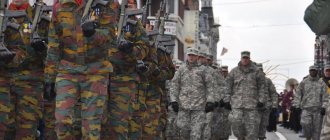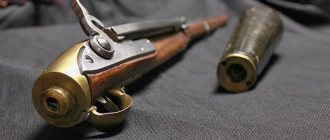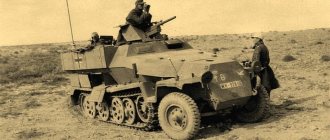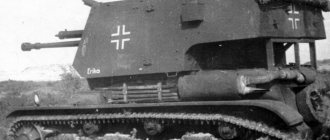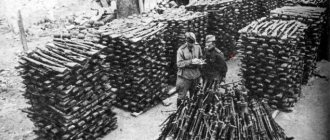The famous order of the Supreme Commander No. 227 (better known as “Not a step back!”) was read to the troops on July 28, 1942. He not only prohibited the withdrawal of troops without orders, but also introduced new units for the Red Army - penal companies and battalions. Contrary to popular belief, this was not “Stalin’s terrible invention.” Similar units appeared in the Wehrmacht much earlier. And the order in the Soviet penal battalions, in comparison with the German penal battalions, was quite humane, if, of course, this word is even appropriate here.
There will be no slobs!
The first “special units” appeared in Germany long before the war, in 1936. At first, they were made up of guilty soldiers - drunkards, deserters, brawlers. There were no “politicians” here - they were sent straight to concentration camps. Then they began to pour in here from prisons criminals who had committed minor crimes and were not completely (according to the Nazis) lost to society - hooligans, thieves, embezzlers. Unlike ordinary soldiers, “special officers” received a reduced salary; they could be given a leave of absence only for exceptionally exemplary behavior. And violators of discipline faced a concentration camp.
Wehrmacht penal battalion.
At the outbreak of World War II, the Wehrmacht had eight special units. They were mainly engaged in construction and engineering work for the army and navy. They were not thrown into battle, and there was no need for this: the Polish campaign was extremely easy for the Wehrmacht. The defeat of the enemy took the Germans a little over a month. After this, the special units were disbanded, as the command decided that “there will be no more cowards and scoundrels in the Wehrmacht.” The former “special officers” were sent to regular units, having forgiven them their previous sins.
Offending soldiers were now sent to some kind of modern disciplinary battalions. They were kept behind barbed wire, engaged in construction and sapper work, but were formally considered military personnel and wore uniforms, although without shoulder straps or stripes. They did not take part directly in the hostilities, although they worked close to the front line. But ahead was June 22, 1941.
Did you know about this? Lubyanka cellars. Part 1
Suicide squads
Only particularly lucky soldiers could end up on court martial and then in a correctional battalion. At the same time, it was actually impossible to atone for guilt here. Such units actually consisted of soldiers doomed to death.
“Penalties” in the Red Army often made excuses after receiving a wound. From the infirmary, the Red Army soldier was sent to an ordinary unit. Some were even awarded medals and orders. In the Wehrmacht, a wounded soldier from a correctional battalion was generally sent back.
So, in France, several servicemen were sent to such a penal battalion for attempting to steal. The soldiers stole a meager amount from the owner of a catering establishment. The same fate befell those who criticized the Nazi leaders, tactics and strategy of battles, etc.
From call to call
Execution of Lithuanian partisans.
Kaunas, 1941. Soon after the attack on the Soviet Union, the Wehrmacht suffered heavy losses. From somewhere, “cowards and scoundrels” immediately appeared. Especially after the counter-offensive of Soviet troops near Moscow. Then parts of the Wehrmacht sometimes retreated in panic, abandoning hundreds of vehicles, tanks, guns... Everything that the Red Army lacked. Hitler, having learned about this, was furious. By order of December 16, 1941, he prohibited retreat without orders from the command (analogous to the future Soviet order “Not a step back!”), Deserters - soldiers and officers - were shot on the spot. When the panicked retreat stopped, 100 penal companies were formed on the Eastern Front, which included the guilty soldiers who escaped execution.
It must be said that during the German retreat from Moscow, military courts handed down about 30 thousand death sentences. And the number of penal prisoners on the Eastern Front was clearly regulated - 16.5 thousand people. Consequently, a little more than half of those sentenced to death after the defeat near Moscow escaped execution. However, they still had little chance of survival.
The fact is that German penal prisoners, unlike Soviet ones, received sentences from six months to five years. And he was supposed to serve it completely. A Soviet penalty soldier could wash away his guilt with blood, that is, after being wounded, he was transferred to a regular unit. The Germans practically did not have such an opportunity. Neither injury nor personal courage could change his situation. Only as a rare exception, the commander petitioned for the hero to be transferred to a regular unit. But during the war years, only a few dozen such cases can be counted. Therefore, if we take it as a percentage, German penal prisoners died with a much higher probability than Soviet ones.
By the way, German penal battalions were clearly distinguished by caste: soldiers, non-commissioned officers and officers. In the Soviets there was no such division.
The emergence of correctional battalions
The first German penal battalions in the Third Reich were created in the late 1930s. Scientists believe that in the penal battalions and field camps of Germany there were almost the same rules as in the concentration camps, but there were their own military personnel.
Previously, Germany had the so-called “special groups” where violators were actually given the opportunity to atone. But since 1939 they began to deal with them.
The Red Army took over penal battalions and barrage detachments from the Nazis. In 1939, Germany and the USSR had not yet become enemies.
Cannon fodder
Penalty units were thrown into the most difficult sectors of the front, and they suffered incredible, by Wehrmacht standards, losses. For example, on March 22, 1942, in a battle near the Kamensky Forest (Samara Region), the 550th penal battalion lost 700 people killed, wounded and missing in one day. On August 16, in one day of fighting near Myasny Bor (Novgorod region), the 540th battalion lost only more than 300 soldiers killed. A year later, in the battles for the Sinyavinsky Heights in the same penal battalion, more than 700 soldiers died in two days.
Did you know about this? How Bartholdi swung for Freedom
SS Penal Battalion. Sonderkommando "Dirlewanger".
Despite the fact that heroism could not in any way influence their Fate, the German penal prisoners fought very well. They especially distinguished themselves in the battles for Stalingrad. When the surrounded Germans ran out of shells for anti-tank guns, it was the penalty soldiers who developed tactics for destroying Soviet tanks on city streets. One group quietly approached the armored vehicle through the ruins, throwing a mine under the track. The second group finished off the tank and its crew with grenades. However, as you know, this did not help the Germans, and Paulus’s group was defeated.
Penalties were also actively used in the battles on Malaya Zemlya near Novorossiysk. In just one of the attacks (this fact was even included in the Sovinformburo reports), Soviet soldiers destroyed more than 300 Nazis with machine-gun fire at point-blank range in a few minutes. These were the fines.
After the defeat on the Kursk Bulge, the attitude towards the penalty prisoners on the part of the command became even worse. For example, when Soviet troops crossed the Dnieper in 1943, numerous corpses of Nazis were found in the trenches and destroyed pillboxes, chained with hand shackles to machine guns. The penalty soldiers could not retreat along with the others, and were forced to shoot back to the last bullet. They didn't even have a chance to come out with their hands up. Almost all of them died.
Towards the end of 1944, penal battalions began to be abolished, and their personnel were transferred to regular units. Often, penal officers with combat experience were used as instructors to train militias, since the Wehrmacht was sorely lacking in personnel soldiers and officers.
PENALTY BATTALIONS OF THE WEHRMACHT
Many firmly believe that penal battalions are a terrible invention of Stalin, who did not hesitate to use the dirtiest methods to win the war. However, Koba is not an innovator in this area. He borrowed the system of such military units from the enemy. Yes, it was the fascists, long before the invasion of the USSR, who formed entire brigades, which included former criminals and antisocial elements.
Little is known about the Wehrmacht penalty soldiers. Only fragments of information have survived to this day, from which we can reconstruct the events of those days.
Hitler's rise to power was marked by mass arrests. According to the decree “On the Protection of the People and the State,” everyone who had somehow offended the Third Reich was seized. But the Fuhrer did not take into account the fact that places in correctional institutions would soon run out. Many prisons could not withstand the influx of more and more batches of prisoners. And then the Wehrmacht found a simple and effective solution.
In 1936, the first unit was formed, the personnel of which was made up of military prisoners who ended up behind bars due to their way of thinking at odds with the ideology of the party, or due to immoral behavior and systematic violation of the regulations.
Initially, one unit was created in each branch of the military. But soon a continuous stream of penal prisoners forced the generals to form regular units, the number of which exceeded 5 thousand people. New “pupils” were sent by unit commanders and the military tribunal.
The most stubborn and desperate were expelled from the army and handed over to the police, who usually sent the stubborn person to a concentration camp. But there were few such insolent people. In the first three years of the existence of the penal units, only 120 people were sent to the camps, because each prisoner understood that it was better to undergo hard service under the tireless supervision of commanders than to die of hunger outside the camp fence.
The beginning of the Second World War was marked by the dissolution of penal units. The Fuhrer considered that the penalty soldiers were unreliable and would desert the battlefield at the first opportunity. But soon the question of creating new battalions arose. The concept has been revised. Soldiers who were difficult to train were considered to be at fault. Here is a list of “sins” for which a person could be sent to a correctional unit: “lazy, careless, dirty, dissatisfied, stubborn, antisocial and asocial individuals, soulless (that’s the wording), cruel, deceitful, swindlers, weak-willed, psychopaths.”
In 1942, the situation at the front became tense. By order of the General Staff, a “testing unit 500” was formed, which was formed from soldiers and officers who had committed misconduct at the front. Once in this battalion, the serviceman was deprived of all ranks, awards and regalia. The 500th battalions were sent to the most difficult sectors of the front. For example, the 561st battalion fought bloody battles with Red Army soldiers at the Sinyavinsky Heights near Leningrad. Both sides suffered colossal losses. The ground was literally strewn with corpses for many kilometers. It was the 500th battalions that the Germans first used as barrier detachments, although they subsequently denied this fact in every possible way.
There was another type of “testing units”, with serial number 999. Prisoners of concentration camps were sent to them. It was they who became cannon fodder, which was driven to slaughter by the detachments. The length of stay in such a unit ranged from 3 to 6 months. Only one out of ten penal prisoners lived to the end of their sentence, after which he was transferred to the 500th unit, where he could fully rehabilitate himself before the Reich.
However, among the “penalties” there was a special unit called the SS division “Dirlewanger”. Its story begins with commander Oskar Dirlewanger, who fought in the First World War. On the battlefields, Oscar received two Iron Crosses. After the war, he attended university, where he received a doctorate in political science.
Dirlewanger was a scumbag and a psychopath. He was sent to prison after he was caught molesting his thirteen-year-old student. Two years of imprisonment did not change his attitude towards the female sex, and soon he again found himself in prison under the same article. But the doctor was a good friend of the Nazi boss Heinrich Himmler, who helped Dirlewanger soon get out of prison.
The old libertine was sent to Spain, where he commanded the Condor Legion, which fought on the side of General Franco. There he was wounded three times, after which Oscar returns to Germany, where he is given the rank of SS Untersturmführer and appointed commander of the Oranienburg poaching unit. It was formed from former hunters convicted of poaching. The group was used to carry out reconnaissance operations in the forests of Europe.
Due to the success of the unit, its staff was expanded to 300 people and renamed the Sonderkommando "Doctor Dirlewanger". In 1941, the battalion was sent to Poland to fight local partisans. The personnel consisted not only of poachers, but also of murderers, rapists, robbers and homosexuals. Once in Poland, the “fighters” began to do what they loved. They raped, killed, robbed and burned entire villages. In July 1942, this battalion killed more than 200 civilians. A few months later, Dirlewanger's group was sent to Belarus, where they broke their own record by killing 1,050 people (mostly women, children and old people) in a few weeks.
Dirlewanger recruited personnel exclusively from those convicted of particularly serious crimes. Thanks to its “achievements,” the Sonderkommando was awarded the title of a regular unit, and the commander himself received another Iron Cross. Even the SS men hated and feared them.
But in 1943 the group was sent to the front. There they were confronted not by helpless civilians, but by well-armed and trained units of the Red Army. In the very first battle, the punishers and murderers suffered a crushing defeat due to the lack of basic combat skills. After which the group was sent to the rear for reorganization. Since then, the detachment has carried out combat missions only in the rear. They were mainly involved in suppressing uprisings in the occupied territories. By this time, the number of wounds of Oskar Dirlewanger himself had reached twelve and he received the fifth Iron Cross. But this did not save him from reprisals.
In 1945, Fritz Schmedes became the new unit commander, and Dirlewanger was sent to a Bavarian hospital. In April 1945, Shmedes, along with his soldiers, surrendered to the Americans, in the hope that they would be treated as prisoners of war. But the allies preferred not to get involved with the penalty box. The entire division's personnel were shot on the spot. Dirlewanger himself fell into the hands of the Poles from the French occupation corps. After several days of torture, he died. This is where the bloody history of the Third Reich penal prisoners ends. But they forever left their terrible mark on the pages of the Second World War.
